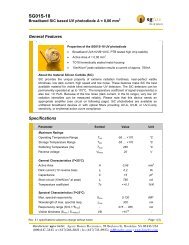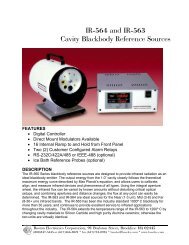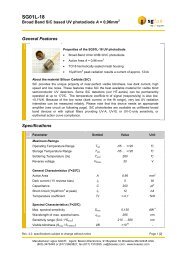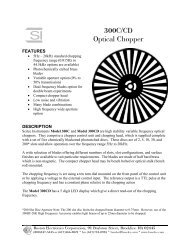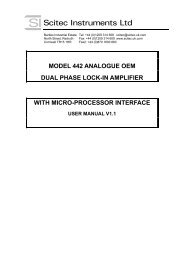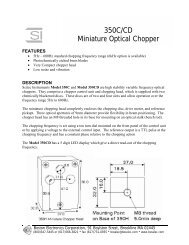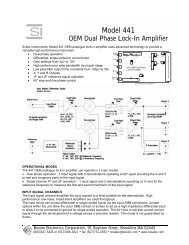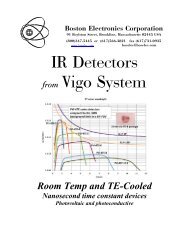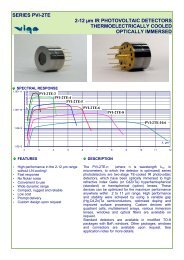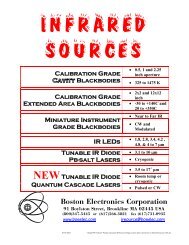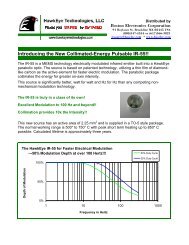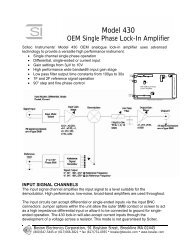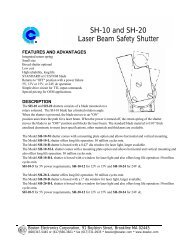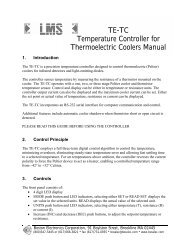TCSPC for FLIM and FRET in - Boston Electronics Corporation
TCSPC for FLIM and FRET in - Boston Electronics Corporation
TCSPC for FLIM and FRET in - Boston Electronics Corporation
You also want an ePaper? Increase the reach of your titles
YUMPU automatically turns print PDFs into web optimized ePapers that Google loves.
Other <strong>TCSPC</strong> TechniquesApplication of <strong>TCSPC</strong> to diffusion <strong>in</strong> cellsDiffusion constants <strong>in</strong> cells are usually determ<strong>in</strong>ed byfluorescence correlation (FCS) techniques. Record<strong>in</strong>gan FCS function requires to detect the fluorescence<strong>in</strong>tensity <strong>in</strong> a fixed spot of the sample <strong>and</strong> to calculatethe autocorrelation function of the <strong>in</strong>tensity or of thephoton detection times [14,15,16]. Although FCS isnot an imag<strong>in</strong>g technique it is often used <strong>in</strong>comb<strong>in</strong>ation with imag<strong>in</strong>g to def<strong>in</strong>e the location <strong>in</strong> acell where an FCS measurement has to be run.Generally, the <strong>TCSPC</strong> technique is not only able torecord time-resolved images <strong>in</strong> laser scann<strong>in</strong>gmicroscopes, but also to recorded FCS data. An FCSmeasurement can even be comb<strong>in</strong>ed with a s<strong>in</strong>glepo<strong>in</strong>t lifetime measurement. The multi-detectortechnique described above <strong>for</strong> <strong>TCSPC</strong> imag<strong>in</strong>g is alsoavailable <strong>for</strong> FCS measurements. With the<strong>in</strong>troduction of the SPC-830 it is not longer necessaryto use <strong>in</strong>dependent modules <strong>for</strong> imag<strong>in</strong>g <strong>and</strong> FCS. TheSPC-830 works <strong>for</strong> imag<strong>in</strong>g <strong>and</strong> FCS record<strong>in</strong>g aswell.FCS data record<strong>in</strong>g does not build up histograms asthe <strong>TCSPC</strong> imag<strong>in</strong>g techniques do. Instead, it recordsthe full <strong>in</strong><strong>for</strong>mation about each photon. Each entryconta<strong>in</strong>s the time of the photon <strong>in</strong> the laser pulseps time from TAC / ADCmicro timeresolution 25 pssequence, the time from the start of the experiment, <strong>and</strong> the detector channel. The data structure isshown <strong>in</strong> Fig. 40. For each detector an <strong>in</strong>dividual correlation spectrum <strong>and</strong> a fluorescence decaycurve can be calculated. An <strong>in</strong>strument like this was used to detect <strong>and</strong> identify s<strong>in</strong>gle molecules ona substrate. By us<strong>in</strong>g four wavelength channels <strong>and</strong> a piezo scann<strong>in</strong>g stage different molecules couldbe identified <strong>in</strong> a time of the order of 1 ms [17]. Moreover, data from different detectors can becross-correlated. By detect<strong>in</strong>g different chromophores <strong>in</strong> different wavelength <strong>in</strong>tervals crosscorrelationcan show whether the molecules of both chromophores <strong>and</strong> the associated prote<strong>in</strong>structures are l<strong>in</strong>ked or diffuse <strong>in</strong>dependently.LaserFIFOBufferPhotonHistogram ofmicro timemicro timemicro time...micro timemicro timepicosecondsLaserFluorescencedecaycurvesDetectorChannelDet. NoDet. NoDet. NoDet. NoReadoutHard disktime from start of experimentStartofexperiment Photonsmacro timeresolution 50 nsmacro timemacro time...macro timemacro timeAutocorrelation ofmacro timens to secondsFluorescencecorrelationspectraFig. 40: Comb<strong>in</strong>ed liftime / FCS data acquisition by<strong>TCSPC</strong><strong>TCSPC</strong> Wide Field Imag<strong>in</strong>g<strong>TCSPC</strong> can be used <strong>for</strong> wide field imag<strong>in</strong>g if a special detector is used. The detector consists of theusual photocathode, a microchannel plate <strong>and</strong> a delay l<strong>in</strong>e system or a four-element anode system atthe output. By measur<strong>in</strong>g the delay of the output pulses at the ends of the delay l<strong>in</strong>es or the chargedistribution at the four anode sectors the location of a photon can be determ<strong>in</strong>ed, see fig. 41.35



